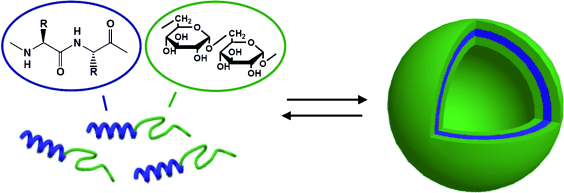Home > Press > Synthetic Capsules Made of Natural Building Blocks
 |
Abstract:
Block copolymer vesicles from protein and sugar components
Synthetic Capsules Made of Natural Building Blocks
Bordeaux, France | Posted on March 23rd, 2009The basis of all life forms are vesicles: membrane-enclosed, liquid-filled "bubbles" made of lipids, proteins, and carbohydrates. Cells, which are separated from the surrounding medium by their cell membrane, are really just big vesicles. Small vesicles play a critical role in the intracellular transport of biomolecules. Synthetic vesicles, such as liposomes and polymersomes, made of lipids and polymers respectively, are used to transport active ingredients in products such as cosmetic or pharmaceutical formulations. They also have potential as microreactors intended to mimic the behavior of living cells. This would be more successful if the vesicles were made of natural components. As reported in the journal Angewandte Chemie, researchers working with Sébastien Lecommandoux and Christophe Schatz at the University of Bordeaux (France) have now attached together blocks of sugar molecule chains (polysaccharides) and protein chains (polypeptides) in a linear fashion. In water, these block copolymers spontaneously form vesicles.
The researchers used dextran, a polymer made of glucose building blocks, and poly(benzyl L-glutamate) (PBLG), a biocompatible polypeptide. By using a series of reactions referred to as "click" chemistry, they attached these molecules to each other blockwise. The advantages of this method are the mild reaction conditions, the nearly quantitative yield, and the fact that other functional side groups on the reactants do not interfere with the reaction.
In this way, the scientists produced block copolymers that combine a polypeptide (protein-like) block and a sugar block. The hydrophobic (water-repellant) polypeptide adopts a helical conformation and in aqueous environments prefers to be side-to-side with those like itself. This results in membrane-like layers that close in on themselves to form spherical vesicles. On both sides of the synthetic membrane, the hydrophilic (water-friendly) dextran chains coil up into a stabilizing "corona". Electron microscope images reveal membranes that are about 21 nm thick surrounding vesicles of a very uniform size (about 45 nm radius).
The researchers would like to use their simple, versatile synthetic strategy to make other synthetic glycopeptides that could be used as model compounds for the exploration of cellular sugar structures (glycomics). The vesicles could also form the basis for a new generation of drug and gene transporters, because their sugar corona binds well to glycoproteins on the surfaces of living cells. The vesicles are also similar to the hulls of viruses and are a first step toward mimicking virus morphology.
Author: Sébastien Lecommandoux, Université de Bordeaux, Pessac (France), recherche.enscpb.fr/lcpo/fr/fichier%20html/perso_lecommandoux-fr.htm
Title: Polysaccharide-block-polypeptide Copolymer Vesicles: Towards Synthetic Viral Capsids
Angewandte Chemie International Edition 2009, 48, No. 14, 2572-2575, doi: 10.1002/anie.200805895
####
Contacts:
Editorial office:
Amy Molnar (US)
Jennifer Beal (UK)
Alina Boey (Asia)
Copyright © Angewandte Chemie
If you have a comment, please Contact us.Issuers of news releases, not 7th Wave, Inc. or Nanotechnology Now, are solely responsible for the accuracy of the content.
| Related News Press |
News and information
![]() Simulating magnetization in a Heisenberg quantum spin chain April 5th, 2024
Simulating magnetization in a Heisenberg quantum spin chain April 5th, 2024
![]() NRL charters Navy’s quantum inertial navigation path to reduce drift April 5th, 2024
NRL charters Navy’s quantum inertial navigation path to reduce drift April 5th, 2024
![]() Discovery points path to flash-like memory for storing qubits: Rice find could hasten development of nonvolatile quantum memory April 5th, 2024
Discovery points path to flash-like memory for storing qubits: Rice find could hasten development of nonvolatile quantum memory April 5th, 2024
Chemistry
![]() What heat can tell us about battery chemistry: using the Peltier effect to study lithium-ion cells March 8th, 2024
What heat can tell us about battery chemistry: using the Peltier effect to study lithium-ion cells March 8th, 2024
![]() Nanoscale CL thermometry with lanthanide-doped heavy-metal oxide in TEM March 8th, 2024
Nanoscale CL thermometry with lanthanide-doped heavy-metal oxide in TEM March 8th, 2024
Possible Futures
![]() Discovery points path to flash-like memory for storing qubits: Rice find could hasten development of nonvolatile quantum memory April 5th, 2024
Discovery points path to flash-like memory for storing qubits: Rice find could hasten development of nonvolatile quantum memory April 5th, 2024
![]() With VECSELs towards the quantum internet Fraunhofer: IAF achieves record output power with VECSEL for quantum frequency converters April 5th, 2024
With VECSELs towards the quantum internet Fraunhofer: IAF achieves record output power with VECSEL for quantum frequency converters April 5th, 2024
Nanomedicine
![]() New micromaterial releases nanoparticles that selectively destroy cancer cells April 5th, 2024
New micromaterial releases nanoparticles that selectively destroy cancer cells April 5th, 2024
![]() Good as gold - improving infectious disease testing with gold nanoparticles April 5th, 2024
Good as gold - improving infectious disease testing with gold nanoparticles April 5th, 2024
![]() Researchers develop artificial building blocks of life March 8th, 2024
Researchers develop artificial building blocks of life March 8th, 2024
Announcements
![]() NRL charters Navy’s quantum inertial navigation path to reduce drift April 5th, 2024
NRL charters Navy’s quantum inertial navigation path to reduce drift April 5th, 2024
![]() Discovery points path to flash-like memory for storing qubits: Rice find could hasten development of nonvolatile quantum memory April 5th, 2024
Discovery points path to flash-like memory for storing qubits: Rice find could hasten development of nonvolatile quantum memory April 5th, 2024
|
|
||
|
|
||
| The latest news from around the world, FREE | ||
|
|
||
|
|
||
| Premium Products | ||
|
|
||
|
Only the news you want to read!
Learn More |
||
|
|
||
|
Full-service, expert consulting
Learn More |
||
|
|
||








